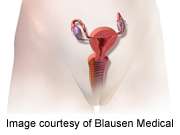Total vaginal hysterectomy generates net hospital income

(HealthDay)—Compared with total vaginal hysterectomy (TVH), hospital costs are greater with laparoscopic assisted vaginal hysterectomy (LAVH), total laparoscopic hysterectomy (TLH), and robotic hysterectomy (RH), according to a study published in the February issue of the American Journal of Obstetrics and Gynecology.
Sandra Dayaratna, M.D., from West Virginia University School of Medicine in Morgantown, and colleagues conducted a retrospective chart review of patients who underwent hysterectomy for benign disease by TVH, LAVH, TLH, and RH between Jan. 1, 2007 and April 30, 2010, at Thomas Jefferson University Hospital. For cost comparisons, potential TVH candidates were identified as a subset of patients with at least one prior vaginal delivery, no more than one laparotomy, and a uterine size less than 14 weeks who had undergone RH, TLH, or LAVH.
The researchers identified 334 cases of minimally invasive hysterectomy; 55 percent TVH, 33 percent LAVH, 3 percent TLH, and 9 percent RH. For TVH, LAVH, TLH, and RH, the mean total hospital costs were $7,903, $10,069, $11,558, and $13,429, respectively (P < 0.0001). For TVH, the net hospital income was $1,260, while the hospital incurred losses were $1,306, $4,049, and $4,564 for LAVH, TLH, and RH, respectively (P = 0.03). TVH would increase from 57 to 76 percent of all minimally invasive hysterectomy with use of the study criteria.
"TVH was the only minimally invasive modality of hysterectomy that generated net hospital income," conclude the authors.
More information:
Abstract
Full Text (subscription or payment may be required)
Copyright © 2014 HealthDay. All rights reserved.


















